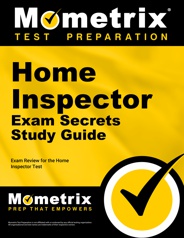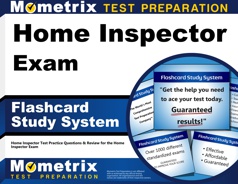The National Home Inspector Examination (NHIE) is designed to evaluate the competency of home inspection professionals to make sure they have the knowledge and understanding necessary to provide valid home inspections. Administered by the Examination Board of Professional Home Inspectors, 35 states and several Canadian provinces currently include the exam as part of their licensing requirements.
Click “Start Test” above to take a free Home Inspector practice test!
Home Inspector Exam Outline
The Home Inspector exam contains 200 multiple-choice questions, 20 of which are “pretest” questions that do not count toward your final score. These pretest questions are used by the test administrators to gauge the quality of the questions for future versions of the exam. You will be given 4 hours to complete the exam.
The questions are split into 3 content domains:
I. Property and Building Inspection (63%)
This domain contains 13 tasks related to inspecting buildings and property and conducting a site review.
Task 1 (5%)
Assess site conditions to identify defects and issues that may affect people and the building’s performance.
- Vegetation, grade, drainage, and retaining walls
- Driveways, patios, and walkways
- Pool and spa access barriers
Task 2 (5%)
Assess exterior components to identify defects and issues that may affect people and the building’s performance.
- Wall cladding, flashing, trim, eaves, soffits, and fascia
- Exterior doors and windows
- Decks, balconies, stoops, stairs, steps, porches, and applicable railings
- Garage vehicle doors and operators
Task 3 (6%)
Assess roof components to identify defects and issues that may affect people and the building’s performance.
- Roof coverings
- Roof drainage systems
- Roof flashings
- Skylights and other roof penetrations
Task 4 (4%)
Assess structural components to identify defects and issues that may affect people and the building’s performance.
- Foundation
- Floor structure
- Walls and vertical support structures
- Roof and ceiling structures
Task 5 (6%)
Assess electrical systems to identify defects and issues that may affect people and the building’s performance.
- Service lateral, service drop, service entrance, service equipment, and service grounding
- Interior components of service panels and subpanels
- Wiring methods
- Devices, equipment, and fixtures
- Alternative energy systems
Task 6 (4%)
Assess cooling systems to identify defects and issues that may affect people and the building’s performance.
- Cooling
- Distribution systems
Task 7 (5%)
Assess heating systems to identify defects and issues that may affect people and the building’s performance.
- Heating
- Distribution systems
- Vent systems
Task 8 (4%)
Inspect conditioned and unconditioned insulation, moisture management systems, and ventilation systems that may affect people and the building’s performance.
- Thermal insulation
- Moisture management
- Ventilation systems of attics, crawl spaces, and roof assemblies
Task 9 (5%)
Assess mechanical exhaust systems to identify defects and issues that may affect people and the building’s performance.
- Mechanical exhaust systems
- Indoor air management systems
Task 10 (5%)
Assess plumbing systems to identify defects and issues that may affect people and the building’s performance.
- Water supply distribution system
- Fixtures and faucets
- Drain, waste, and vent systems
- Water heating systems
- Fuel storage and fuel distribution systems
- Drainage systems, sump pumps, sewage ejection pumps, related valves, and piping
Task 11 (4%)
Assess interior components to identify defects and issues that may affect people and the building’s performance.
- Walls, ceiling, floors, doors, windows, and other interior system components
- Steps, stairways landings, and railings
- Installed countertops and cabinets
- Smart Homes
Task 12 (6%)
Assess fireplaces, fuel-burning appliances, and their chimney and vent systems to identify defects and issues that may affect people and the building’s performance.
- Solid fuel-burning
- Gas and liquid fuel-burning fireplaces and appliances
Task 13 (4%)
Assess common permanently installed kitchen appliances for proper condition and operation.
- Applicable standards, installation methods, and terminology
- Basic operation using normal controls
- Typical defects
- Common safety issues
II. Analysis and Reporting (25%)
This domain contains 5 tasks related to analyzing and reporting findings of an inspection/site review.
Task 1 (6%)
Inform the client of what was inspected and describe the building systems and components.
Task 2 (4%)
Describe the inspection methods used and the limitations in the inspection report to inform the client as to what was NOT inspected and why.
Task 3 (5%)
Describe the inspected systems and components that are defective/not functioning properly.
Task 4 (5%)
Describe the systems and components that are in need of further assessment or action.
Task 5 (5%)
Describe the implications of the defects to ensure the client understands what might occur if the defects are not attended to.
III. Professional Responsibilities (12%)
This domain contains 2 tasks related to the various professional responsibilities of a home inspector.
Task 1 (7%)
Obtain a written preinspection agreement and discuss its elements with the client or representative to establish the rights and responsibilities of the client and the inspector.
Task 2 (5%)
Maintain a high standard of quality, objectivity, and integrity throughout the inspection process.
Check out Mometrix's Home Inspector Study Guide
Get practice questions, video tutorials, and detailed study lessons
Get Your Study Guide
Registration
For most states, you can register online or by phone with PSI to take the exam at any of the 220 test centers located throughout the United States. However, if you are applying for a license in Florida, Illinois, Nevada, South Dakota, Texas, Vermont, or Washington State, you are required to register and take the exam through companies specifically contracted to administer the exam in those states. Some states also have additional questions specific to home inspection in that state.
Fees
During registration, you will need to pay the exam fee, which is generally $225 if you are testing in the US ($325 in Canada). You may be eligible for exam fee reimbursement if you pass the exam and are eligible for GI Bill education benefits.

Test Day
You should arrive at the testing center at least 15 minutes prior to your scheduled exam time. If you arrive late, your exam will be forfeited, and you will not be refunded the exam fee.
Once you arrive, you will be asked to provide your confirmation number, photo ID, and any other documents the state requires. Your picture will then be taken, which will be printed on your score report. You will also be asked to leave all personal belongings such as bags, study materials, cell phones, and papers outside the testing area.
Before the exam begins, you will be given the chance to familiarize yourself with the computer system, which will not count against your time.
Note that you will not be allowed to use a calculator during the test, and any attempt to copy or photograph any part of the exam, use previously written notes, or remove testing materials from the testing room will result in your immediate dismissal from the testing center.
The Home Inspector exam is scored on a scale of 200-800, and you must achieve a scaled score of 500 to pass.
You will receive your score report before you leave the testing center.
Check out Mometrix's Home Inspector Flashcards
Get complex subjects broken down into easily understandable concepts
Get Your Flashcards
Study Tips
How to Study Effectively
Your success on Home Inspector test day depends not only on how many hours you put into preparing but also on whether you prepared the right way. It’s good to check along the way to see whether your studying is paying off. One of the most effective ways to do this is by taking Home Inspector practice tests to evaluate your progress. Practice tests are useful because they show exactly where you need to improve. Every time you take a free Home Inspector exam practice test, pay special attention to these three groups of questions:
- The questions you got wrong
- The ones you had to guess on, even if you guessed right
- The ones you found difficult or slow to work through
This will show you exactly what your weak areas are and where you need to devote more study time. Ask yourself why each of these questions gave you trouble. Was it because you didn’t understand the material? Was it because you didn’t remember the vocabulary? Do you need more repetitions on this type of question to build speed and confidence? Dig into those questions and figure out how you can strengthen your weak areas as you go back to review the material.
Answer Explanations
Additionally, many Home Inspector practice tests have a section explaining the answer choices. It can be tempting to read the explanation and think that you now have a good understanding of the concept. However, an explanation likely only covers part of the question’s broader context. Even if the explanation makes sense, go back and investigate every concept related to the question until you’re positive you have a thorough understanding.
Comprehend Each Topic
As you go along, keep in mind that the Home Inspector practice test is just that: practice. Memorizing these questions and answers will not be very helpful on the actual test because it is unlikely to have any of the same exact questions. If you only know the right answers to the sample questions, you won’t be prepared for the real thing. Study the concepts until you understand them fully, and then you’ll be able to answer any question that shows up on the test.
Strategy for Home Inspector Practice
When you’re ready to start taking practice tests, follow this strategy:
- Remove Limitations. Take the first test with no time constraints and with your notes and Home Inspector study guide handy. Take your time and focus on applying the strategies you’ve learned.
- Time Yourself. Take the second practice test “open book” as well, but set a timer and practice pacing yourself to finish in time.
- Simulate Test Day. Take any other practice tests as if it were test day. Set a timer and put away your study materials. Sit at a table or desk in a quiet room, imagine yourself at the testing center, and answer questions as quickly and accurately as possible.
- Keep Practicing. Keep taking practice tests on a regular basis until you run out of practice tests or it’s time for the actual test. Your mind will be ready for the schedule and stress of test day, and you’ll be able to focus on recalling the material you’ve learned.
Home Inspector Online Prep Course
If you want to be fully prepared, Mometrix offers an online Home Inspector prep course designed to give you everything you need to succeed!
Here’s what you’ll find in the Home Inspector course:
- 30+ Review Lessons Covering Every Topic
- 400 Home Inspector Practice Questions
- 250+ Digital Flashcards
- Money-back Guarantee
- Mobile Access
Everyone learns differently, so we’ve tailored the Home Inspector online prep course to ensure every learner has what they need to prepare for the Home Inspector exam.
Click below to check it out!
FAQs
Q
How hard is the Home Inspector exam?
A
This exam is considered to be difficult, but taking the time to adequately study before the exam will help ensure you succeed.
Q
How many questions are on the Home Inspector exam?
A
There are 200 multiple-choice questions on the exam.
Q
How long is the Home Inspector exam?
A
The exam is timed at 4 hours.
Q
What is a passing score for the Home Inspector exam?
A
To pass the exam, you will need to achieve a scaled score of 500.
Q
How much does the Home Inspector exam cost?
A
The cost of the exam may vary slightly depending on which state or province you take the exam in. Generally, the US fee is $225, while the fee in Canada is usually around $325.


